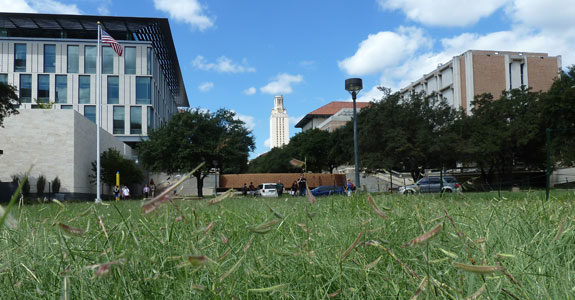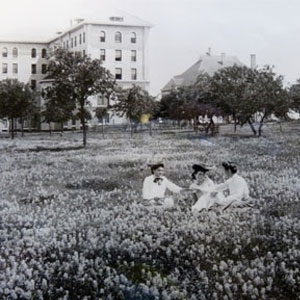Higher Learning
Wildflower Center ecologists envision a more sustainable university campus

As consultants to the university’s master planning process, Wildflower Center ecologists are recommending replacing non-native lawn with HABITURF®, a mix of native turfgrass that demands less water and fewer resources than traditional lawn. This small installation of HABITURF is already in place on campus.

TOP: Conducting an ecological site assessment informed Center ecologists of existing erosion. Improving stormwater management practices would help prevent erosion and its effect on nearby Waller Creek. BOTTOM: An expanse of St. Augustine lawn at the University of Texas at Austin campus.
University landscapes – that is – are expected to meet the needs of student life and typically there is a certain design aesthetic in mind, says environmental designer Michelle Bright. "We wanted to show that it’s possible to meet those objectives as well as help the site function better from an ecological standpoint."
The team started with an ecological site assessment. A typical master plan assessment, Bright explained, records a park bench here, a garbage can over there. Center ecologists looked at the campus through a new lens, making note of invasive species, existing native plants such as Texas’ legendary live oak trees as well as non-natives such as thirsty St. Augustine turfgrass. They took soil samples that helped determine the soil health on the site and assessed drainage conditions – critical because of the campus’ location near the city’s Waller Creek.
"This process challenged us as ecologists because usually we are evaluating sites that are not ecologically pristine — but closer to that state than could ever be true of an urban college campus," says Bright. "What’s exciting is that there are a lot of opportunities available to improve landscape health on campus with measures that make a difference to the surrounding environment."
For example, Bright and the team will recommend managing stormwater that falls onsite in such a way that it does not pollute nearby Waller Creek. They will also suggest appropriate native plants that are more resilient than existing plants.

The university has definitely set off on the right foot by implementing native plants and trees and landscape approaches such as those seen here, designed by Ten Eyck Landscape Architects.

Check out those bluebonnets! This photograph from 1904 shows an entirely different campus than the one we know today. In place of lawn is a field of bluebonnets — a source of beauty and resource for pollinators. Prints and Photographs Collection, di_04396, The Dolph Briscoe Center for American History, The University of Texas at Austin.
Another measure Bright and others from the Center’s team are proud of is how they’ll establish a survey for use by the landscape maintenance staff at UT. The survey will ask staff to rank plants by how much maintenance and water they have found they need. The hope is to answer which native and appropriate non-native species take less irrigation. “When water restrictions demand that potable water be cut off for plantings, staff will know how to respond,” says Bright.
She explains the project as a way to get intimate with the ecological setting in the urban environment. Bright says, "We are not attempting to restore the landscape here to its historical precedent, but generate ecological function and build ecological resilience into the university grounds for the benefit of the campus community."
By Christina Kosta Procopiou
Photographs by Michelle Bright
No comments:
Post a Comment